Porcelain Insulator News
by Elton Gish
Reprinted from "Crown Jewels of the Wire", July 1992, page 14
The Porcelain Insulator News article in the November, 1991 issue of Crown
Jewels described problems with the insulators on the Niagara, Lockport &
Ontario power line. That line, originally constructed with the large, and
undiscovered M-3890's, prompted interest from many of you. As it turned out, Ken
Willick had already walked sections of that line, which had been upgraded many
years ago with suspension insulators. Some of his finds were reported in PIN in
the March, 1992 issue of CJ. This line was put into service in 1906 with
M-3890's, and much of it was upgraded in 1909 with M-4338's. Recently, Steve
Jones and Bob Berry were invited by Ken on a field trip to that line. Ken took
them to two substations, several line sections, and dump sites where thousands
of insulator shards were beckoning them to dig -- and dig they did! Both Steve and
Bob sent the following photographs and stories to me, so we can share them with
you. From the pictures, you can imagine their excitement. You may want to refer
to the pictures in the November PIN, pages 18-20, and in the March PIN, pages
8-13. I edited and merged the two stories from Bob and Steve.
NIAGARA POWER ADVENTURE
On an invitation from Ken Willick and his wife Denise, Steve Jones and
Bob
Berry traveled into the "ultimate insulator country" along the
Niagara, Lockport & Ontario power line and the Niagara to Buffalo line
(started in 1896) ! It was a dismal weekend, but Ken and Denise's gracious
hospitality more than made up for it. Ken and Denise live in Lima, N.Y., home of
the Lima Insulator Co. (1904-1908), and currently the Industrial Ceramics Company
(formerly PINCO). It is also very near Victor, where power porcelain was first
developed by Fred M. Locke. Their main goal, however, was to have a look at the
early Niagara power lines, which used many of the most classic styles of early
multipart porcelain insulators.
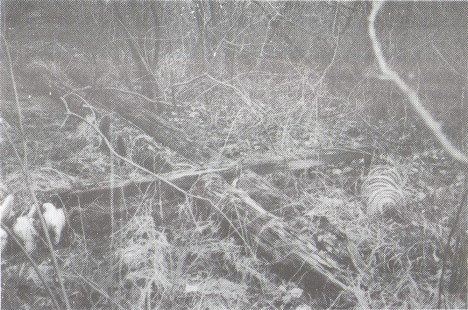
J-D suspension strings are still attached to the wooden pole.
Bob, Steve and Ken decided to take a vacation
day to make the weekend a little longer, so they started off early on Friday. On
the way, they stopped at one old line to look around. From the first, they were finding broken pieces of
tan M-3890's, VICTOR M-4338 cross-tops in blue-gray, and Ohio Brass crosstops (M-????) in a beautiful purplish-gray! The pieces were all too smashed to try and
reconstruct a specimen, but the hearts of the three mud-hounds were pounding
just the same! They also found some Jeffery-Dewitt suspension disks in blue,
still attached to the old, partially decayed wooden poles laying on the ground
(see photo above). Bob and Steve lugged a bunch of these out. They are now
hanging from Bob's deck, along with several other glass and porcelain suspension
strings. Bob said that many of the J-D disks were broken where the spiders were
attached probably due to freeze damage. On the way back, Bob found a top of a
M-3890 still cemented to the original pin (see photo below). The pin was
solid steel, and weighed about 35 pounds!
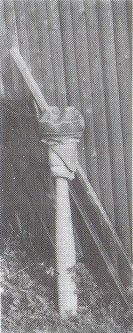
Solid steel pin cemented in crown of M-3890
By the time Bob and Steve got back to
Ken's, they were rather muddy and tired. Ken and Denise fed them a great dinner,
and then they spent some time (albeit a lot of time) looking over Ken's great
collection of threadless and classic power insulators. Between digging for threadless,
digging in various dumps, and searching along power lines, Ken has many great
stories to tell.
After a brief night's rest, they got up early Saturday morning to again hunt
for the elusive big power pieces. Unfortunately, it had started to rain, but
this did not dampen the spirits of the three true multi hunters.
Ken first took
them to a section of line where there were several old dumps. Needless to say,
the two greenhorns were in shock when they saw their first dump. There were
piles and piles of broken and smashed gray cross-tops, M-3890's made by both New
Lexington and Thomas, suspension disks, uniparts, smaller multipart styles, and
much, much more. Everything was pretty well bashed, but they did find cross-top
pieces marked with both the "VICTOR" marking, and "VICTOR / R=oo"
insulator logo (see photo below) ! They also found the remains of a light gray
suspension disk with the small "VICTOR / R=oo" marking!
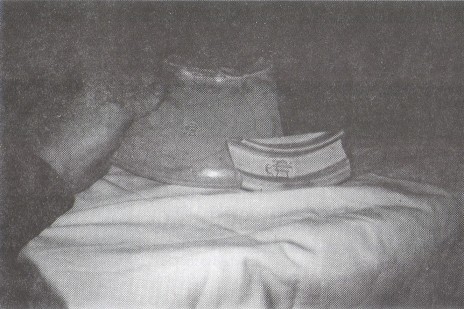
Pieces of gray M-4338 with "VICTOR / R=oo" insulator logo.
.In another dump, they found a nearly whole M-3250 with a mottled brown glaze
(see photo on next page). Both the top and bottom skirts are mint, but very
little was left of the middle skirt. Inside the bottom skirt are the typical
"blue- jean" seam marks characteristic of pre-1910 Thomas. Even more
exciting was finding pieces of a WHITE M-3250 ! ! Too bad that there was so much
damage (see photo on next page). Bob grabbed all of the pieces that he could
find, but they seemed to be from several different insulators, rather than the
same one, because the pieces did not fit together. Some of the pieces also have
the Thomas "blue-jean" seam markings.
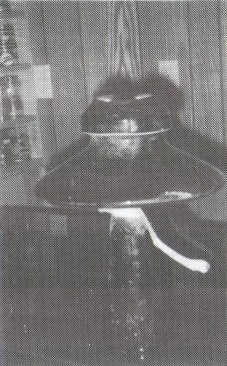
Mottled brown Thomas M-3250
They then walked several sections of the Niagara-Buffalo line where they
found pieces of classic Imperial styles: U-934's, brown U-966's, and Ken even
found a piece of an Imperial U-937! What a bright ending for a dark and rainy
day. They then returned to Lima exhausted, but excited about all that they had
seen. Bob said that he had many "insulator dreams" that night.
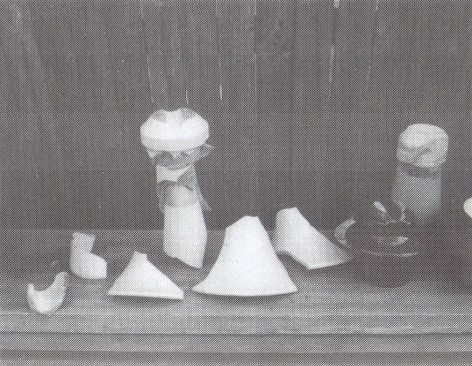
White Thomas M-3250
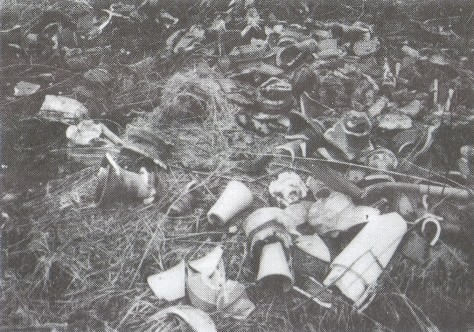
Dump littered with broken classic multiparts
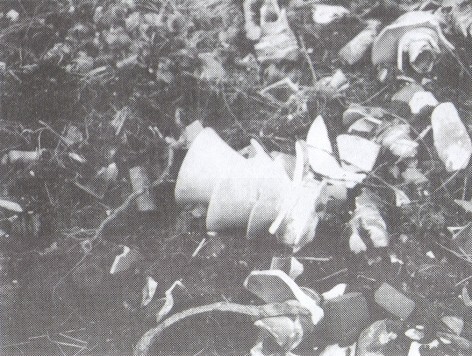
The best gray M-4395 Ohio Brass cross-top found in the dump.
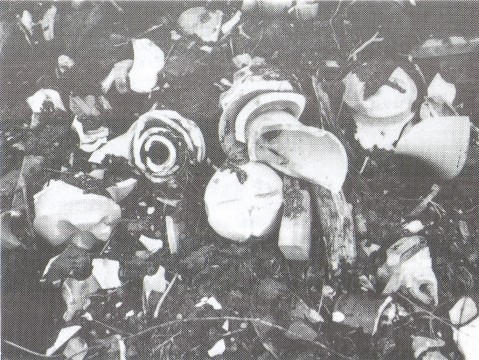
Close-up of gray cross-top pieces in the dump.

Bob Berry (left) and Ken Willick (right) digging
in the dump where pieces of M-3890's were found.
They
were up early again on Sunday to try another dump. This was an amazing dump - -
more cross-tops and M-3890 pieces! They dug and looked around for quite awhile,
and found only very smashed pieces. Spirits were low with so many smashed pieces
under every shovel full of earth. Every time it was the same -- broken and
jagged pieces. Then, Bob pulled out a nearly mint M-3890 top skirt! ! Soon they
had uncovered several decent tops. They also found some decent bottom skirts,
but they did not find any pieces of the middle skirts. There was no cement in
any of these skirts, which lead them to believe that they were probably left-overs
from the onsite cementing operation where the insulators were assembled. Steve
found one M-3890 top skirt with the "MAY 23" incuse marking
underneath. He also found a smashed Nicholson arcing ring. These rings were
installed on M-3890's and M-4338's circa 1909, in an effort to protect them from
flashovers caused by nearby lightning strikes.
Bob and Steve will hold many
lasting memories of this trip. They want to thank Ken and Denise for
their
great hospitality, and for a truly "multi-ful" weekend sharing these
great insulator finds. Below are a few more pictures from their trip. What are
Bob and Steve planning next? They are planning a trip along a line that used Thomas (Boch) U-928A's
and U-944's, and also U-945 "Mershon
Type"! Good luck guys! !
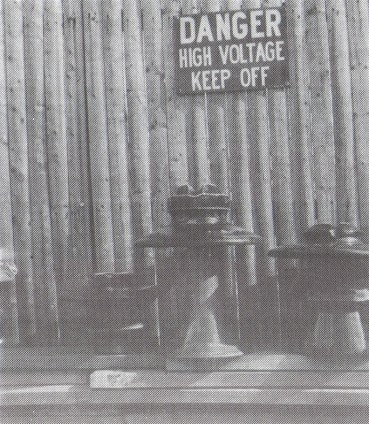
Thomas M-2926, M-3890 (minus middle skirt), Pittsburg M-4340
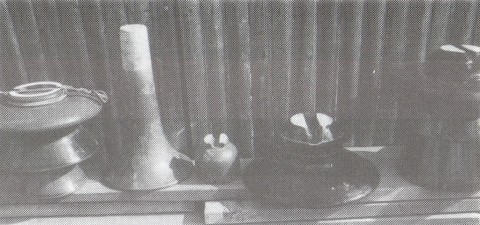
Bottom skirt and top skirt of M-3890 compared to brown U-928
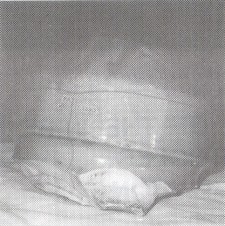
Crown of M-3890 with incuse markings
"NEW LEXINGTON, O."
and
"PATENTED / JUNE 17, 1890"
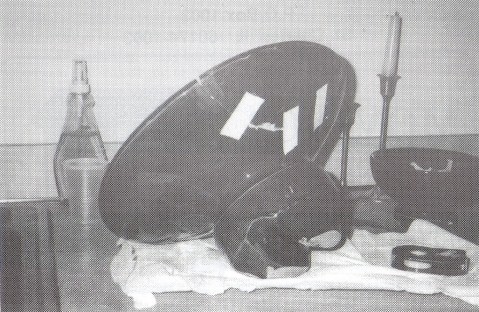
Steve Jones' repair job on a top skirt from a New Lexington M-3890.
It has a light reddish tan glaze.
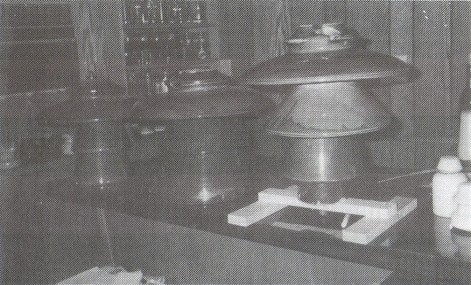
Bob Berry's Fred Locke multiparts: M-3725, M-4384, M-3721
| 